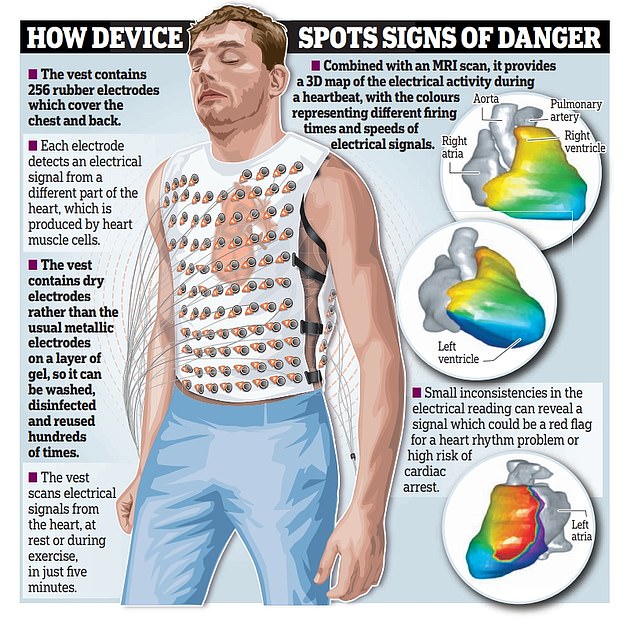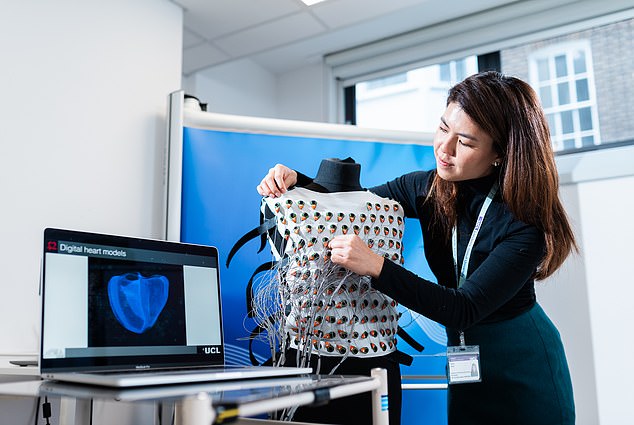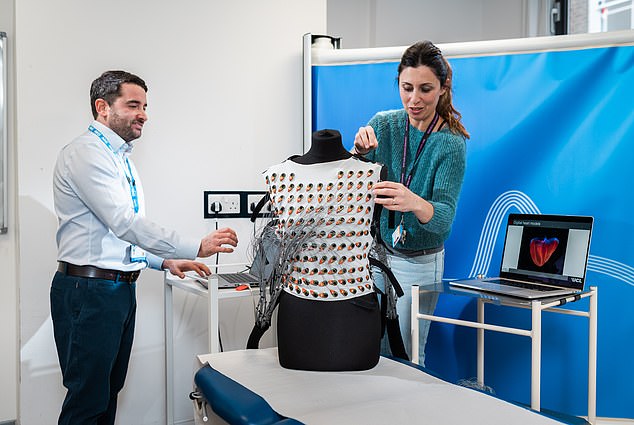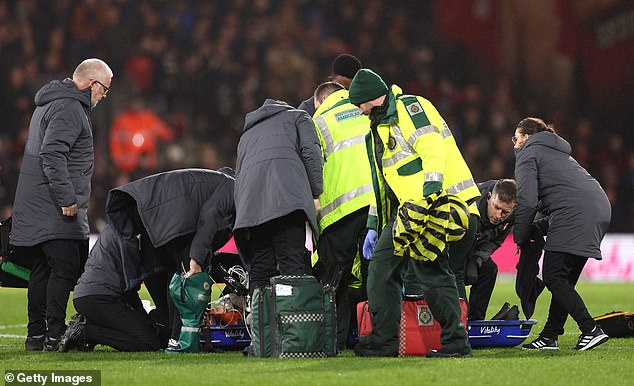After a footballer collapses on the pitch, scientists unveil a vest that maps the electrical activity of the heart with the potential to save thousands of lives
A vest that maps the electrical activity of the heart in detail could save thousands of lives.
Patients with suspected heart problems currently receive a standard ECG, which uses twelve leads that are taped to the chest, arms and legs.
But this test, performed alongside an MRI scan, takes only a small portion of the electrical signals that make the heart beat.
Scientists have now created an entire vest with 256 individual electrodes, worn across the chest and back, that can pick up many more electrical signals as they radiate from the heart.
The vest produces a more detailed picture of heart activity in just five minutes and could save lives by detecting more people with dangerously fast heart rates who may need an implanted defibrillator in their chest, and people with slow heart rates who may need a pacemaker .
Scientists have now created an entire vest with 256 individual electrodes, worn across the chest and back, that can pick up many more electrical signals as they radiate from the heart


The vest could save lives by detecting more people with dangerously fast heart rates, who may need a defibrillator implanted in their chest, and helping identify people with slow heart rates, who may need a pacemaker

Two million people with heart rhythm problems in Britain could benefit from the technology
In the future, the vest could be used to better identify young, healthy people at high risk of sudden cardiac arrest, such as 29-year-old Luton Town captain Tom Lockyer, who collapsed on the football field for the second time this year. Saturday, and was taken to the hospital.
Researchers have shown that the technology can detect abnormalities in the heart's electrical rhythm in apparently healthy people, but the technology has not yet been used to predict which of these people are at risk of going into cardiac arrest.
Lockyer remained in hospital yesterday, while Luton Town FC informed well-wishers of the situation on social media site
There are also around two million people with these heart rhythm disorders in Britain who could benefit from the technology, as slow diagnosis could also put them at greater risk of death from cardiac arrest.
The vest, which can be reused hundreds of times after being machine washed or disinfected, could offer hope of a clearer diagnosis for many people with heart failure in Britain whose hearts are not pumping enough blood.
Often these people, who have heart failure after an event such as a heart attack, will also develop a fast or slow heart rate.
But for those who aren't at risk of developing a heart rhythm problem, the vest could prove this, by revealing that their heart's electrical activity is largely normal, based on preliminary research results.

Luton Town's Tom Lockyer receives emergency care after collapsing during the Premier League match between AFC Bournemouth and Luton Town at Vitality Stadium in December

In the future, the vest could be used to better identify young, healthy people at high risk of sudden cardiac arrest, such as 29-year-old Luton Town captain Tom Lockyer
It means that some people with heart failure can avoid getting unnecessary pacemakers and defibrillators, or getting powerful medications they don't need.
The vest, funded by the British Heart Foundation and already used for research in a number of London hospitals, has been used successfully on 800 patients but has not yet been tested on all the different types of heart patients it could help.
It is currently being used to map the hearts of people with genetic conditions such as hypertrophic cardiomyopathy, which affects around one in 500 people in Britain, and to determine the difference in heart rhythms between younger and older people and 'super-agers' to demonstrate. who reach old age with a healthy heart.
Although it has mainly been used to look at heart rhythm problems in the lower chambers of the heart, researchers think it could also help people with the most common form of irregular heartbeat, called atrial fibrillation – which affects the upper chambers of the heart. .
The number of cases of atrial fibrillation has increased by 50 percent in the past decade and patients need to be diagnosed early to reduce their higher risk of stroke.
Dr. Gaby Captur, from University College London and the Royal Free Hospital London, who invented the vest, said: 'This vest could be fast, affordable and potentially help save thousands of lives by identifying people at risk of life-threatening heart rhythms. .' They are cells in the heart muscle that transmit electrical signals and respond to them.
The electrical activity causes these cells to squeeze inward, causing the entire heart muscle to contract and then relax, creating the regular heartbeat that pumps blood to the rest of the body. A rapid heart rate, which can cause cardiac arrest even in young, healthy people, could be caused by a broken electrical signal, which the new vest can detect.
An equally dangerous slow heart rate can also be diagnosed based on an intermittent electrical signal, although researchers have not yet tried this. It's critical that people still get an MRI scan of their heart, but the vest can provide an additional 3D map of the electrical activity throughout the heart.
Until now, detailed mapping of the heart's electrical activity has been rare. Either a catheter had to be inserted into the heart or expensive single-use devices used with CT scanners, which create radiation.
Dr. Matthew Webber, who trialled the vest at the UCL Institute of Cardiovascular Science, said: 'In-depth electrocardiographic imaging can help us link problems with the heart muscle to the impact they can have on the heart's electrical system.
“It adds an essential missing part of the puzzle.”
Dr. Sonya Babu-Narayan, associate medical director of the British Heart Foundation, said: 'This innovative approach, which combines MRI imaging of heart scars with more detailed electrical data than the run-of-the-mill ECG, has the potential to accelerate breakthroughs to identify who may at risk. of cardiac arrest before it happens.”
